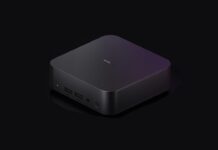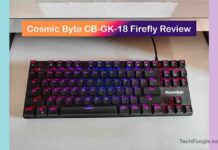Features
ASUS surprised everyone at Computex 2013 when it announced the mini-ITX form factor Maximus VI Impact board during the ROG event. Till now we had only seen the ROG moniker – which corresponds to ASUS’s gamer-oriented products – on the Formula and Extreme series of ATX boards and Gene series of microATX boards. The Impact brings the mini-ITX form factor to the ROG table from this generation onwards.
Table of Contents
PRICE IN INDIA
19,950 TechTrainIndia Rating:= 7.5
Average User Rating:= 7.5
The ASUS Maximus VI Impact features the LGA 1150 socket for the 4th generation Intel processors. It has the Z87 chipset but unlike its other ROG counterparts sporting four DIMM slots for RAM, the Impact has just two DIMM slots. Considering this is an ROG board, interesting bundled accessories are expected and ASUS does not disappoint on that front.
The highlight accessory is the SupremeFX Impact sound adapter which is like a dedicated mini sound card for the board. The SupremeFX adapter slides into a dedicated socket on the board just beside the LAN port. According to ASUS it provides around 115dB signal-to-noise ratio for analog outputs and a 110dB signal-to-noise ratio operational amplifier for the headphones output. This allows the user to use both a graphics card and a dedicated sound card, which is not possible with regular mini-ITX boards as majority of them come with just a single PCIe x16 slot.
The next important accessory is the mPCIe Combo II card which houses a Bluetooth 4.0 and 802.11 ac wi-fi adapter. On one side of the PCB you have the wireless adapter whereas on the other side you have the Next Generation Form Factor (NGFF) M.2 socket for mSATA or mPCIe form factor SSDs, thereby adding a future-proofing capability.
There are four fan connectors in all with three of them concentrated in the top left hand corner of the board. Coming to the rear side, you have all the major connectors you can hope for from a high end board: 4x USB 2.0 ports, 4x USB 3.0 ports, LAN port, DisplayPort and HDMI port, optical S/PDIF out, eSATA port. There is an Impact Control section which houses the two digit POST debug LED, ROG Connect button, a clear CMOS button, MemOK and a DirectKey.
Coming to the UEFI BIOS, it is similar in appearance to other ROG boards’ BIOS. It keeps things simple and by default, there isn’t any home page which then leads to the advanced menus, as was seen in the ASUS P8 series boards. Though that has its advantages, we think that a majority of the ROG board users would just want to get straight to business. Apart from the Extreme Tweaker, Advanced and other menus, ASUS has also added small touches such as explaining the setting you are about to tweak on the right hand side, giving you a summary of the changes you have made in a particular session before you save your settings, shortcuts to reach your settings quicker and so on.
The Maximus VI Impact features the utilities we have seen in its elder siblings such as the Maximus VI Extreme. It comes with Sonic Radar which allows FPS gamers to find out the direction of sound such as footsteps, gun shots and so on. You can even select which sound modes you want the Sonic Radar to detect. The ASUS Dual Intelligent Processors 4’s 4-way optimisation allows you to tweak various settings such as fan speeds, CPU performance and so on.
Package Bundle
– User Manual
– Driver CD
– I/O Shield
– 4x SATA 6 Gbps cables
– 1x ASUS Q-cable
– 1x SupremeFX Impact audio card
– 1x Optional 4-in-1 washers for CPU cooler backplate
– 1x ASUS Wi-Fi 802.11a/b/g/n/ac compliant antenna
– 1x mPCIe Combo II card with dual-band WiFi 802.11 a/b/g/n/ac + Bluetooth v4.0/3.0+HS module
Board Layout and Design
The ASUS Maximus VI Impact has quite a dense layout and you will hardly find any breathing space on the board except around the CPU cooler screw sockets. ASUS has ensured that you get pretty much everything expected of an ROG board including a powerful VRM section, dedicated Start and Reset buttons, POST code read out and so on. Let’s look at the board from every angle.
The CPU section has the standard LGA 1150 socket. There is sufficient clearance for stock coolers. On the right hand side you have the two DIMM slots, which have a fixed notch at one end which is beside the VRM section. The notches on its other side are flexible helping in fitting and removing RAM sticks. Under the DIMM slots you have the 24-pin ATX power slot and the 8-pin motherboard power slot located side-by-side, which is a rare sight. The large round Start button and its smaller companion Reset button are located to the left of the power ports. At the lower end you have a USB 3.0 connector. Above the DIMM slots on the left hand side you have four SATA ports pointing upwards.
Above the CPU socket you have the Impact Power section which houses chokes and capacitors which makes up the voltage regulator module. The vertical design of the Impact Power section ensures that there is sufficient area around the CPU socket. We found this a rather innovative way of making the most out of limited space.This section gets a sturdy passive heatsink having the ASUS branding.
Coming to the bottom edge, you have the single PCIe x16 slot above which you have the Z87 chipset which is covered by a sturdy matte black heatsink. On the left hand side of the bottom edge you have two slots – one for the SupremeFX sound card and the other for the mPCIe Wi-fi and Bluetooth adapter.
The rear side of the board is flush with connectors as were discussed above. We really liked how ASUS has managed to incorporate most of its high end features keeping in mind the limited space provided by the mini ITX form factor. To optimise space, ASUS has gone vertical – Impact power section, Impact control section and so on.
Test Setup
Processor: Intel Core i7-4770K
Motherboards: ASUS Maximus VI Impact, ASUS Maximus VI Extreme, ASRock Z87M Extreme4, MSI Z87-GD65, Gigabyte G1 Sniper 5
RAM: 2x 4GB GSkill Ripjaws @ 1866MHz
Graphics: Intel HD 4600, Palit GTX 770 (only for high end games)
Cooler: Stock cooler
PSU: Cooler Master 800W Silent Pro Gold
OS: Windows 7 Ultimate 64-bit
Monitor: BenQ GL2250
Performance
Before starting the tests, we updated all the boards with their latest BIOSes and updated all the necessary drivers. Motherboards having the same chipset show fairly little variance in the scores as you will notice below.
Synthetic Benchmarks (Higher is better)
Overclocking the processor using the various ways provided by ASUS ROG board is quite easy. We found the auto-tuning option in the dual-intelligent processors ROG utility quite handy as it gives single-click overclocking presets. We found overclocking via the BIOS convenient and you can also save your presets in the form of profiles. We could take the Intel Core i7-4770K to 4.7GHz over air. Cinebench R11.5 gave a score of 10.16 on overclocked settings up from 8.62 on stock settings.
Verdict and Price in India
ASUS ROG boards are for a niche audience, primarily gamers. The ROG Maximus VI Impact is a niche within a niche – gamers looking at a small form factor machine, which does not compromise on anything. Naturally, the price point of Rs19,950 is on the higher side for most users, considering this is a mini-ITX form factor board. But in terms of features, there is barely any competition to the Maximus VI Impact in the mini-ITX segment. Overclocking is easy using the ASUS utilities as well as via the BIOS.
Go for this board only if you are looking for a feature-rich board for building a small form factor gaming machine. Another option you can consider, if you plan to have a multi-GPU setup is the ASUS Maximus VI Gene which is a microATX form factor board with the ROG branding coming for around Rs 17,100. If gaming isn’t your prerogative, but you want to get a more basic Z87 mini ITX board, then you can check out ASRock Z87E ITX which comes for around Rs 13,000.
Specifications
CPU |
|
|---|---|
| CPU Type | Intel Core i7/Core i5/Core i3/Pentium/Celeron |
| Socket Type | Socket 1150 |
| Form Factor | Mini ITX |
Chipset |
|
| Northbridge | Intel Z87 |
Memory Support |
|
| Memory Slots | 2 |
| Max. Memory | 16GB |
| Dual Channel Support | Yes |
Expansion Slots |
|
| PCI Express 2.0 x16 | 1 |
Storage |
|
| SATA 6 Gb/s ports | 4 |
| SATA RAID | 0/1/5/10 |
Onboard Devices |
|
| Audio Channels | 8 |
Rear Panel Ports |
|
| USB | 4 x USB 3.0, 4 x USB 2.0 |
| S/PDIF Out | Yes |












